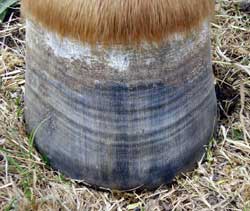Farmstyle is delighted to introduce Carol Layton as a contributor of articles focusing on managing horses on small properties. Carol brings a lifetime of experience and considerable expertise in horse matters, particularly in equine nutrition management and training.
Laminitis symptoms and causes
This article, the first in a two-part series, will look at a common but often undetected disorder of horses: dietary induced low-grade laminitis – symptoms and causes (part two will cover prevention, management and rehabilitation). This should be of considerable interest to any small farm operation where horses are part of the 'farm family', be they a child's pet or farm owner’s hobby and passion.
Pastures and laminitis in horses
Horses have evolved on a diet of low fat and high fibre. Pastures are generally the best type of forage to provide this feed source. Most pastures, even those grown in low fertility situations, can be a good source of fibre, protein, minerals and vitamins for horses although in some situations, deficiencies and imbalances with some nutrients can and do occur.
 |
Paradoxically, pasture and hay that are usually considered nutritious feed for a grazing animal can also be a health hazard for horses, especially those pastures developed to maximise growth rates in cattle and other livestock. These tend to be improved pastures high in easily digestible carbohydrates called sugars and starch.
Since horses evolved on vegetation low in sugar and starch (which provided them a survival advantage), the high levels of easily digestible carbohydrates now found in modern pastures can be too much for some horses. This is especially the case in spring, when warmer temperatures promote the growth of new pasture that is rich in these nutrients.
Laminitis symptoms
Low-grade laminitis in horses (lameness, inflammation, and increased temperature in the hoof) is a milder form of laminitis where the horse does not show any of the obvious, catastrophic symptoms. This is far more common than many horse owners realise. Often a horse owner is unaware that an episode is even occurring since the horse may not initially show obvious pain or discomfort in the hooves.
Horses that are subject to an episode of low-grade laminitis may undergo the following changes in hooves, stance or behaviour:
- Horizontal ridges (rings) forming on the exterior of the hoof.
- Inflammation and eventual separation of the laminae or leaf-like folds in which the pedal bone is normally suspended leads to a separation of the hoof wall from the hoof. This is seen as a widening of the laminae, particularly at the toe, and has the effect of making the horse more susceptible to hoof abscesses.
- Rather than standing normally, the horse will shift its weight from one foot to the other. If the hind limbs are more affected, the horse will stand with its front limbs back underneath it to take more weight.
- Demonstrating a reluctance to step out when ridden.
- Reluctance to pick up feet.
In time, the low-grade laminitis symptoms could develop into tenderness on any surface with a strong ‘bounding’ pulse to the feet – indicating increased blood flow and inflammation to the area. This chronic laminitis may then develop further with pedal bone rotation and solar penetration, known as ‘founder’.
Causes of laminitis
Dietary induced laminitis is a very complex condition that can affect individual horses differently and can be influenced by numerous factors, including:
- Seasonal variation in pasture sugar and starch content, with early spring pasture being the highest risk. New shoots of pasture are higher in sugar and starch.
- Type of pasture – legumes such as clover being particularly rich.
- Pasture that is stressed from drought or frost is higher in sugars and starch.
- Horses with a history of prior laminar disease (whether from laminitis, puncture wounds or severe sole abscesses) seem more susceptible to subsequent bouts of laminitis.
- Overweight horses have a higher predisposition to laminitis.
- A horse in regular work is less likely to be affected.
Laminitis prevention
Fortunately there are many practical prevention, management and rehabilitation strategies to this disease that a horse owner can readily put into practice. These will be covered in the next article of this two-part series.
Where to from here?
For further information on laminitis in horses visit Equine cushing’s disease or Balanced equine nutrition. If you are considering keeping horses, we recommend you purchase a copy of Horse Agskills. This book is a basic guide to many of the skills used when handling, riding and caring for horses.
About the author
Carol Layton (B.Sc M.Ed) is a keen horse endurance rider with a passion for equine nutrition, training and management. She offers independent feeding advice and optimised, mineral balanced diets for horses and can be contacted at Balanced equine nutrition.
Acknowledgement
Thanks to Natural Horse World for the horse hoof image showing stress rings, an indication of laminitis.


